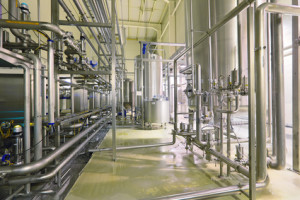The Impact of a Membrane Filtration Pre-Concentration or Whey Fractionation on a Falling Film Evaporator
- Posted on 11th January 2014
- in Falling Film Evaporators
- by Jan de Geest
 GLM Hydro Evaporator Problem Solving: – In the dairy industry we typically find in most milk and whey processing facilities, that membranes are used to pre-concentrate dairy products. For instance milk or whey is typically pre-concentrated by means of a Reversed Osmosis (R.O.) membrane filtration. A simple yet effective way to pre-concentrate dairy products by removing water.
GLM Hydro Evaporator Problem Solving: – In the dairy industry we typically find in most milk and whey processing facilities, that membranes are used to pre-concentrate dairy products. For instance milk or whey is typically pre-concentrated by means of a Reversed Osmosis (R.O.) membrane filtration. A simple yet effective way to pre-concentrate dairy products by removing water.
A Nano Filtration (N.F.) or R.O. step can also be used to demineralize whey, removing some of the ashes and salts from the whey. It is also possible to use a NF or RO step for the concentration of lactose. Ultra Filtration (U.F.) and Micro Filtration (M.F.) can be used to make Whey Protein Concentrate (WPC) or Whey Protein Isolate (WPI). As you can see the application for membrane treatment is very diverse, all producing additional valuables from the whey products.
All of these pre-concentration or fractionation steps have an impact on the performance of the evaporator. We have customers running older unmodified evaporators on new whey related products, where they try to compensate the product change only by changing the process parameters. This may work to an extent in some cases, but generally you need to modify the evaporator to get a secure performance.
Increased Solids
Many customers increase the feed solids to the falling film evaporator, trying to keep the water evaporation the same as the original design. The result is a higher output of concentrate and an increase of powder production.
To give you an example calculation; if the original design has 50,000 PPH of feed at 5% T.S. going to 3,846 PPH of 65% T.S. of concentrate feeding the dryer. So the original water evaporation is 50,000-50,000x 5/65=46,154 PPH of water. With an increase of solids in the feed and trying to match the water evaporation, the new conditions will be 54,600-54,600×10/65=46,200 PPH of water evaporation, 8,400 PPH of concentrate at 65% T.S.
Compared to the original design the output of concentrate is more than twice the original concentrate flow at roughly the same amount of water evaporation. This means that at the back end of the evaporator the volume of liquid is also much higher than the original design. Without modifications to the distribution system, this will likely lead to overflowing of the distribution pans. Some of the boiling tubes will get to much liquid and others may starve because of the high motion of the liquid in the distribution pan. This will also lead to a much higher flow on the concentrate pumps, without modifications the levels in the passes will increase and back mixing may start to happen. Taking all of this in consideration, we advise to take a look at the new application and research the impact on the distribution system and concentrate pumps.
Different Properties Require Modifications
In case the new product is not the original skimmed milk, whole milk or sweet or acid whey but more a permeate or a WPC product, that will lead not only to different loads on the distribution pans and the concentrate pumps, now you are evaporating a product with complete different properties. The viscosities will be different which at a minimum requires modifications to the distribution system. The product will also have a different (higher) boiling point elevation, this will result in different pressure and temperature profiles throughout your evaporator. I have seen many cases where the Thermal or Mechanical Vapor Re-compressor had to bring more Delta-T because of the boiling point elevation increase of the product. This will lead the compressor to run closer to the surge line.
In case you run a higher calcium product and there is more calcium fouling than in the original design you will have to modify your CIP. For example create a more effective acid wash on you distribution pans, to avoid them from plugging with calcium flakes. Run a different CIP cycle optimized for the fouling you are facing now and make the proper changes to the CIP system, customize your cleaning to perform best on your type of fouling.
When you are running an evaporator on a “new” product without modifications, please research the product and your installations specs, there will be a lot to gain by making the proper modifications to the evaporator system.
Contact us for more information when your installation has these or any other kind of issues.
- Calcium Fouling in Barometric Leg of a Direct-Contact Condensor - October 19, 2020
- GLM Luebbers - January 14, 2020
- Capacity Improvement of your Existing Falling Film Evaporator with a Potential Increase on the Dryer Output - January 18, 2014
Tags: Dairy, Falling Film Evaporator, Filtration, Membrane Filtration, Whey
